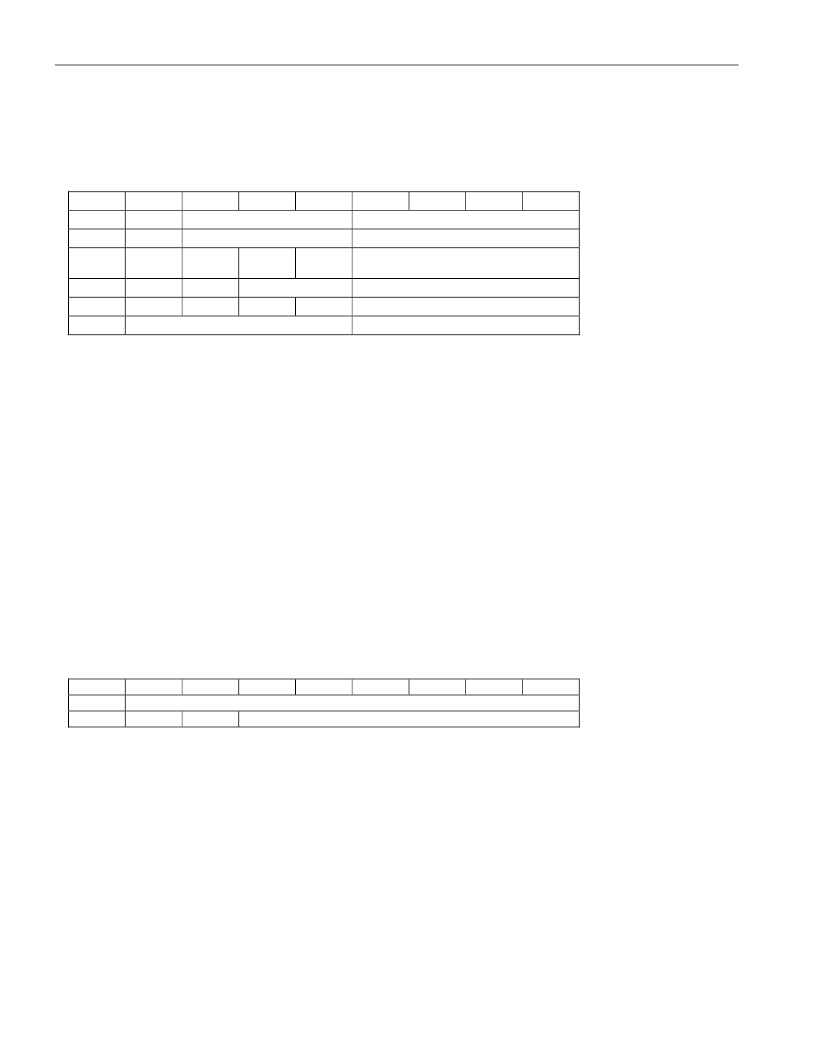- 您現(xiàn)在的位置:買賣IC網(wǎng) > PDF目錄358701 > DS1922L-F5 Temperature Logger iButton With 8kB Datalog Memory PDF資料下載
參數(shù)資料
| 型號(hào): | DS1922L-F5 |
| 英文描述: | Temperature Logger iButton With 8kB Datalog Memory |
| 中文描述: | 溫度記錄儀iButton的記憶與8kB的數(shù)據(jù)記錄 |
| 文件頁(yè)數(shù): | 16/48頁(yè) |
| 文件大?。?/td> | 428K |
| 代理商: | DS1922L-F5 |
第1頁(yè)第2頁(yè)第3頁(yè)第4頁(yè)第5頁(yè)第6頁(yè)第7頁(yè)第8頁(yè)第9頁(yè)第10頁(yè)第11頁(yè)第12頁(yè)第13頁(yè)第14頁(yè)第15頁(yè)當(dāng)前第16頁(yè)第17頁(yè)第18頁(yè)第19頁(yè)第20頁(yè)第21頁(yè)第22頁(yè)第23頁(yè)第24頁(yè)第25頁(yè)第26頁(yè)第27頁(yè)第28頁(yè)第29頁(yè)第30頁(yè)第31頁(yè)第32頁(yè)第33頁(yè)第34頁(yè)第35頁(yè)第36頁(yè)第37頁(yè)第38頁(yè)第39頁(yè)第40頁(yè)第41頁(yè)第42頁(yè)第43頁(yè)第44頁(yè)第45頁(yè)第46頁(yè)第47頁(yè)第48頁(yè)

DS1922L/DS1922T
16 of 48
TIMEKEEPING AND CALENDAR
The real-time clock (RTC)/alarm and calendar information is accessed by reading/writing the appropriate bytes in
the register page, address 200h to 205h. For readings to be valid, all RTC registers must be read sequentially
starting at address 0200h. Some of the RTC bits are set to 0. These bits will always read 0 regardless of how they
are written. The number representation of the real-time clock registers is BCD format (binary-coded decimal).
Real-Time Clock and RTC Alarm Register Bitmap
ADDR
0200h
0201h
0202h
b7
0
0
0
b6
b5
10s
10min.
20hr
AM/PM
b4
b3
b2
b1
b0
Single Seconds
Single Minutes
12/24
10hr
Single Hours
0203h
0204h
0205h
0
0
0
10 Date
Single Date
Single Months
Single Years
CENT
0
10m.
10yrs
The RTC of the DS1922L/T can run in either 12-hour or 24-hour mode. Bit 6 of the Hours Register (address 202h)
is defined as the 12- or 24-hour mode select bit. When high, the 12-hour mode is selected. In the 12-hour mode, bit
5 is the AM/PM bit with logic 1 being PM. In the 24-hour mode, bit 5 is the 20-hour bit (20 to 23 hours). The CENT
bit, bit 7 of the Months Register, can be written by the user. This bit changes its state when the years counter
transitions from 99 to 00.
The calendar logic is designed to automatically compensate for leap years. For every year value that is either 00 or
a multiple of 4 the device will add a 29
of February. This will work correctly up to (but not including) the year 2100.
SAMPLE RATE
The content of the Sample Rate Register (addresses 0206h, 0207h) specifies the time elapse (in seconds if EHSS
= 1, or minutes if EHSS = 0) between two temperature logging events. The sample rate may be any value from 1 to
16383, coded as an unsigned 14-bit binary number. If EHSS = 1, the shortest time between logging events is 1
second and the longest (sample rate = 3FFFh) is 4.55 hours. If EHSS = 0, the shortest is 1 minute and the longest
time is 273.05 hours ( sample rate = 3FFFh). The EHSS bit is located in the RTC Control Register at address
0212h. It is important that the user sets the EHSS bit accordingly while setting the Sample Rate Register.
A
sample rate of 0000h is not valid and must be avoided under all circumstances. This will cause the device
to enter into an unrecoverable state.
Sample Rate Register Bitmap
ADDR
0206h
0207h
b7
b6
b5
b4
b3
b2
b1
b0
Sample Rate Low
0
0
Sample Rate High
During a mission, there is only read access to these registers. Bits cells marked "0" always read 0 and cannot be
written to 1.
TEMPERATURE CONVERSION
The DS1922L measures temperatures in the range of -40°C to +85°C. With the DS1922T the temperature range
begins at 0°C and ends at +125°C. Temperature values are represented as a 8- or 16-bit unsigned binary number
with a resolution of 0.5°C in the 8-bit mode and 0.0625°C in the 16-bit mode.
The higher temperature byte TRH is always valid. In the 16-bit mode only the three highest bits of the lower byte
TRL are valid. The five lower bits all read zero. TRL is undefined if the device is in 8-bit temperature mode. An out-
of-range temperature reading will be indicated as 00h or 0000h when too cold and FFh or FFE0h when too hot.
相關(guān)PDF資料 |
PDF描述 |
|---|---|
| DS1992 | 1kb/4kb Memory iButton |
| DS1993 | 1kb/4kb Memory iButton |
| DS1992L-F5 | 1kbit/4kbit Memory iButtonTM DS1994 4-kbit Plus Time Memory iButtonTM |
| DS21349DK | T1/J1 Line Interface Unit Design Kit |
| DS2149DK | T1/J1 Line Interface Unit Design Kit |
相關(guān)代理商/技術(shù)參數(shù) |
參數(shù)描述 |
|---|---|
| DS1922L-F5# | 功能描述:iButton Temp Logger Ibutton w/8Kb Datalog Mem RoHS:否 存儲(chǔ)類型:SRAM 存儲(chǔ)容量:512 B 組織: 工作電源電壓:3 V to 5.25 V 接口類型:1-Wire 最大工作溫度:+ 85 C 尺寸:17.35 mm x 5.89 mm 封裝 / 箱體:F5 MicroCan 制造商:Maxim Integrated |
| DS1922L-F5#A20 | 功能描述:iButton RoHS:否 存儲(chǔ)類型:SRAM 存儲(chǔ)容量:512 B 組織: 工作電源電壓:3 V to 5.25 V 接口類型:1-Wire 最大工作溫度:+ 85 C 尺寸:17.35 mm x 5.89 mm 封裝 / 箱體:F5 MicroCan 制造商:Maxim Integrated |
| DS1922L-F5#A22 | 功能描述:iButton RoHS:否 存儲(chǔ)類型:SRAM 存儲(chǔ)容量:512 B 組織: 工作電源電壓:3 V to 5.25 V 接口類型:1-Wire 最大工作溫度:+ 85 C 尺寸:17.35 mm x 5.89 mm 封裝 / 箱體:F5 MicroCan 制造商:Maxim Integrated |
| DS1922L-F5#W | 功能描述:iButton RoHS:否 存儲(chǔ)類型:SRAM 存儲(chǔ)容量:512 B 組織: 工作電源電壓:3 V to 5.25 V 接口類型:1-Wire 最大工作溫度:+ 85 C 尺寸:17.35 mm x 5.89 mm 封裝 / 箱體:F5 MicroCan 制造商:Maxim Integrated |
| DS1922L-F5/A1E | 功能描述:iButton RoHS:否 存儲(chǔ)類型:SRAM 存儲(chǔ)容量:512 B 組織: 工作電源電壓:3 V to 5.25 V 接口類型:1-Wire 最大工作溫度:+ 85 C 尺寸:17.35 mm x 5.89 mm 封裝 / 箱體:F5 MicroCan 制造商:Maxim Integrated |
發(fā)布緊急采購(gòu),3分鐘左右您將得到回復(fù)。